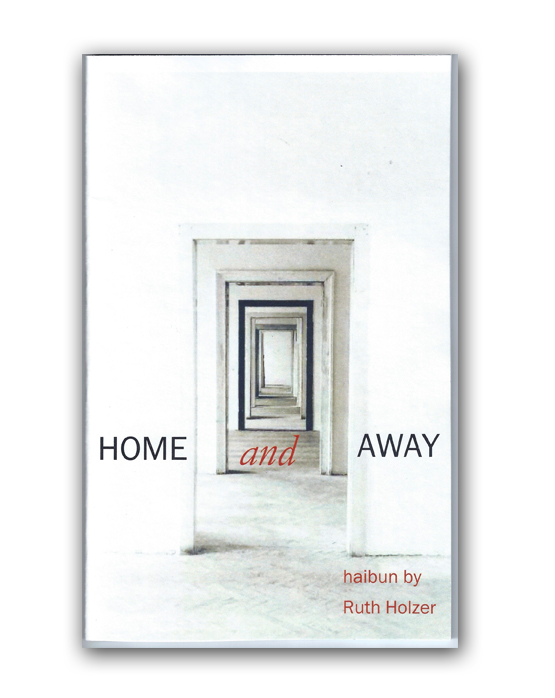
Book Review: Home and Away
By Ruth Holzer
Published by Dancing Girl Press & Studio
2021, paperback, 40 pages
$7.00 US
Available from the author at holzerruth@yahoo.com
Reviewed by Glenn G. Coats

The author of five chapbooks of free verse and ghazals, Ruth Holzer is also an accomplished writer of haiku and haibun. Over the past decades her work has been published in many prominent haikai journals and anthologies, and from 2014 to 2016 she and I worked together as co-editors of Haibun Today. Her long devotion to the form of haibun is reflected in her new chapbook.
Home and Away was published during the ongoing pandemic, at a time when most of the world spent a great deal of time inside—at home. In this chapbook’s 32 haibun, Ruth looks back at her various homes, from childhood into adult life.
The cycle of poems begins with a large tenement in the eastern part of America, which she shares with various generations of her family.
Fire escapes zigzagged over the tenement’s yellowish facade. The first steep flight of marble stairs led to a landing with the grandparents’ apartment. On the second landing was the apartment with the unmarried aunts. We were on the third floor, next to my cousins. Higher up was a woman who howled at the full moon every month, and above her, the dangerous, prohibited rooftop.
This haibun, “Main Street,” ends with, “Eventually, the family dispersed and disappeared.” The capping haiku provides the why.
childhood home—
a superhighway
runs through it
In “Hidden Place,” we learn about Ruth’s closest childhood friend, whose well-kept home—”a barn-red house at the end of a leafy street that had the look of a country lane”—may as well have been in another country compared to the author’s tenement apartment. The haibun ends with a sudden twist and a strong, poignant haiku.
My friend had green eyes and long red hair that flowed behind her in a wild mane as she ran. Still in her teens, she eloped with a Colombian to Florida. Her own daughter died young.
September dusk—
our roller skates clicking
over the slats
After the tenement home, there is a first-floor rental on a quiet street followed by the only house her parents ever owned.
Tuxedo Parkway
This was the first and only house my parents owned, finally buying it when Dad’s employment seemed secure: a two-story brick duplex with a rental unit. They stayed there for over forty years, and although Mom got mugged a few times on the way back from the corner grocery store and Dad’s car was stolen right out of the driveway and the last set of tenants trashed their apartment before absconding, they would have remained there to the end of their days, clinging to life, as Dad said. But then he fell.
sewer seepage the dark at the bottom of the stairs
Each line of prose comprises carefully chosen words that conjure emotions without ever stating them. There is a directness to Ruth’s writing, with shifts that can startle. In “Messervy Street,” for example, Holzer recounts her annual vacation to an aunt’s house near the sea. Usually, a vacation would conjure idyllic memories, but she describes something a bit different.
I’d climb down to the beach, picking my way barefoot over broken bottles and globs of tar. I’d swim among poisonous purple jellyfish and climb the jagged, barnacle-covered rocks. Strewn on the sand were blue and pearl mussel shells, periwinkles, tangled lengths of seaweed, crab claws and silvery fish speckled with flies.
endless summer—
outliving
all my family
Time passes as each haibun unfolds. At one point, Ruth notes how some memories are harder to recall while others remain vivid in the author’s mind. I recognize those moments in my own life when I am trying to remember conversations from a long-ago picnic or the sound of someone’s voice that I knew only as a child. As Ruth writes:
sand in bottle. . .
grain by grain
losing it(from “Rockport”)
As if to anchor her memories, the titles of the haibun provide a litany of locations—Prosper Street, Drift Street, Holly Park Farm—where the author lived as she grew up, entered college, became an adult. As she moves out of childhood, “Home” becomes wherever Ruth is staying (the “Away” in the book’s title.) “Drift Street” recalls Ruth’s last summer at college. She is living with several other girls in a rough part of town, works as a waitress and stays up all night. “I owned two pairs of jeans and a black and white marbled composition book, blank.” Holzer stays until she can no longer afford the rent. She captures those moments in life when there is little thought given to tomorrow.
senior year—
I barely remember
the fetal pig
After college there are apartments, new jobs, as well as specific place names that I suddenly recognize: Doylestown, Peace Valley, Delaware Canal, New Hope, Upper Black Eddy. Holzer is writing about the county in Pennsylvania where I lived longer than any other place in my life, and where she seemed especially happy. “Everything I needed was there: fall raptor migration, farmers’ markets, historic houses by candlelight,” Ruth writes in “Washington Street,” before shifting again, leaving the readers to fill in the blanks.
Then I was laid off from the fish-stick plant and then there was the car crash.
moving on—
the juniper seedlings
come with me
There are more places, more stops along the way (Colorado, Wisconsin, New Jersey and its Passaic River, New York City’s Central Park). She describes relationships that work and others that do not. I assume that all of the poems are about Ruth, but I have no way of knowing that. The haibun thread their way like photographs, snippets of a life, parts of stories.
Ruth returns home to be with her gravely ill father in “The Great Wall.” She and her sister relearn streets they once knew. They stop for Chinese food near the train station: “From curled cookies, we read our fortunes as though they were oracles, as though they could save us.” She caps her poignant haibun with this haiku.
between
the sick and the well
the Great Wall
The haibun in Home and Away cover a lifetime, and the book reminds me of others that showed a way to tell the story of my own childhood. I think of Nights Under a Tin Roof by James A. Autry, The Longest Time by Richard Straw, Cruising Paradise by Sam Shepard, and A Boy’s Seasons by Cor van den Heuvel. Those books encouraged me to remember, and to take an honest hard look at my life. Home and Away belongs with those recollections. Ruth Holzer’s excellent collection of haibun provides a blueprint, a pathway for other poets to follow when looking back.
day break. . .
wherever you are
I will take you home(from “A Safe Place”)
About the Reviewer

Glenn G. Coats lives with his wife, Joani, in Carolina Shores, North Carolina. His books include two recent collections of haibun, A Synonym for Gone (Snapshot Press, 2021) and Degrees of Acquaintance (Snapshot Press, 2019), and Furrows of Snow (Turtle Light Press, 2019), which won an honorable mention in the Haiku Society of America’s 2020 Merit Book Awards.

Textured language, a treat to read.